
[MVP][WIP] `less` like pager (#6984)
Run it as `explore`.
#### example
```nu
ls | explore
```
Configuration points in `config.nu` file.
```
# A 'explore' utility config
explore_config: {
highlight: { bg: 'yellow', fg: 'black' }
status_bar: { bg: '#C4C9C6', fg: '#1D1F21' }
command_bar: { fg: '#C4C9C6' }
split_line: '#404040'
cursor: true
# selected_column: 'blue'
# selected_row: { fg: 'yellow', bg: '#C1C2A3' }
# selected_cell: { fg: 'white', bg: '#777777' }
# line_shift: false,
# line_index: false,
# line_head_top: false,
# line_head_bottom: false,
}
```
You can start without a pipeline and type `explore` and it'll give you a
few tips.
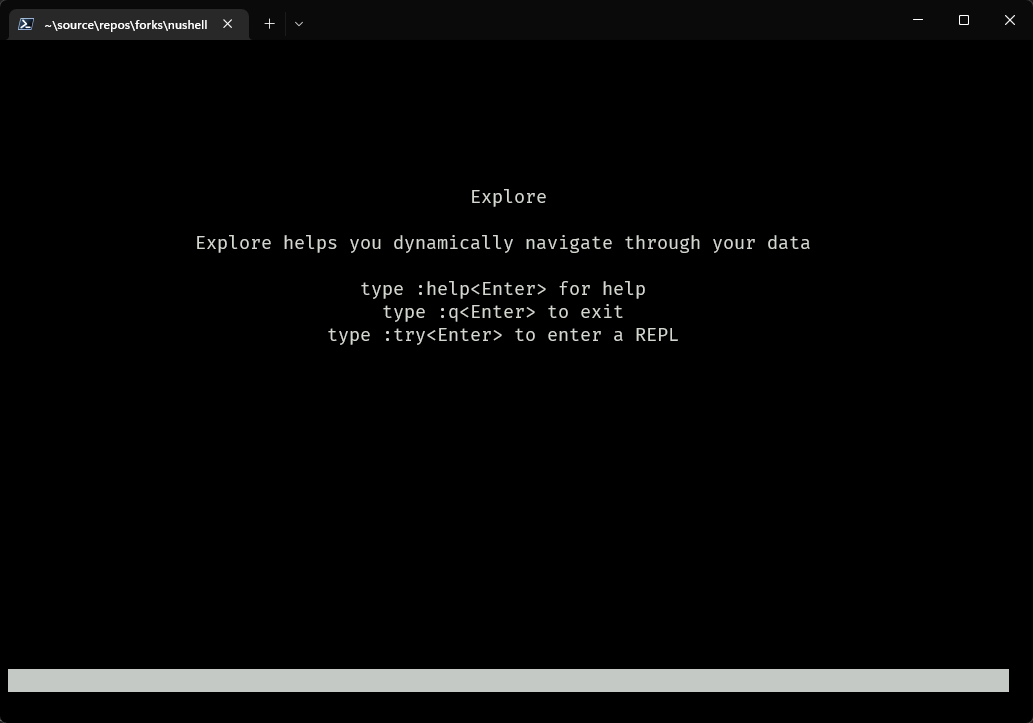
If you type `:help` you an see the help screen with some information on
what tui keybindings are available.
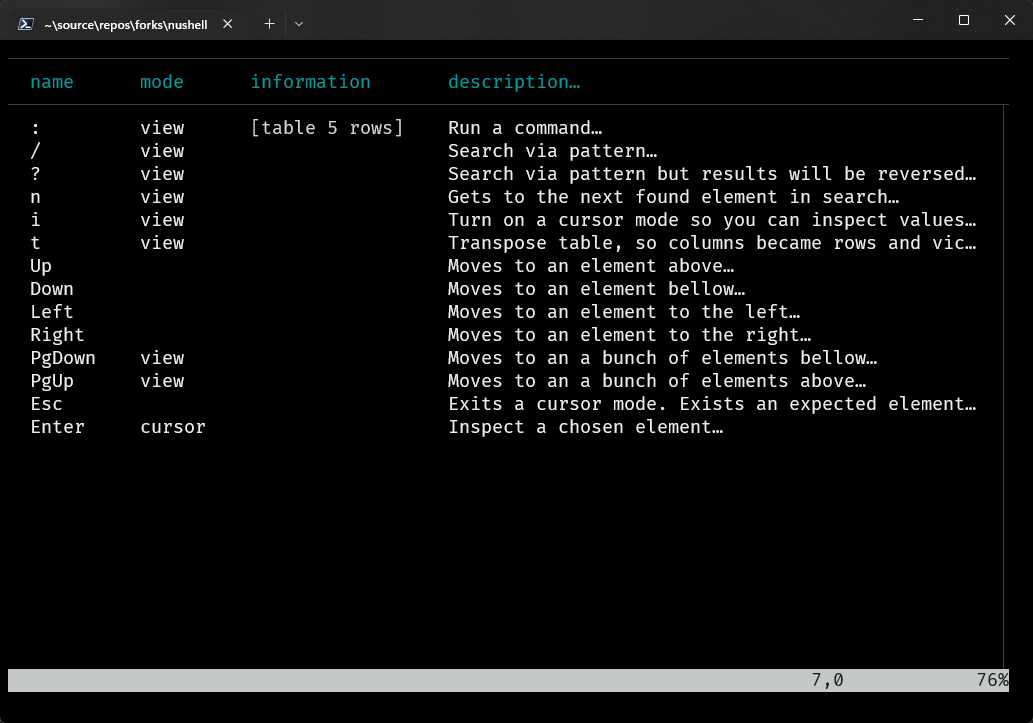
From the `:help` screen you can now hit `i` and that puts you in
`cursor` aka `inspection` mode and you can move the cursor left right up
down and it you put it on an area such as `[table 5 rows]` and hit the
enter key, you'll see something like this, which shows all the `:`
commands. If you hit `esc` it will take you to the previous screen.
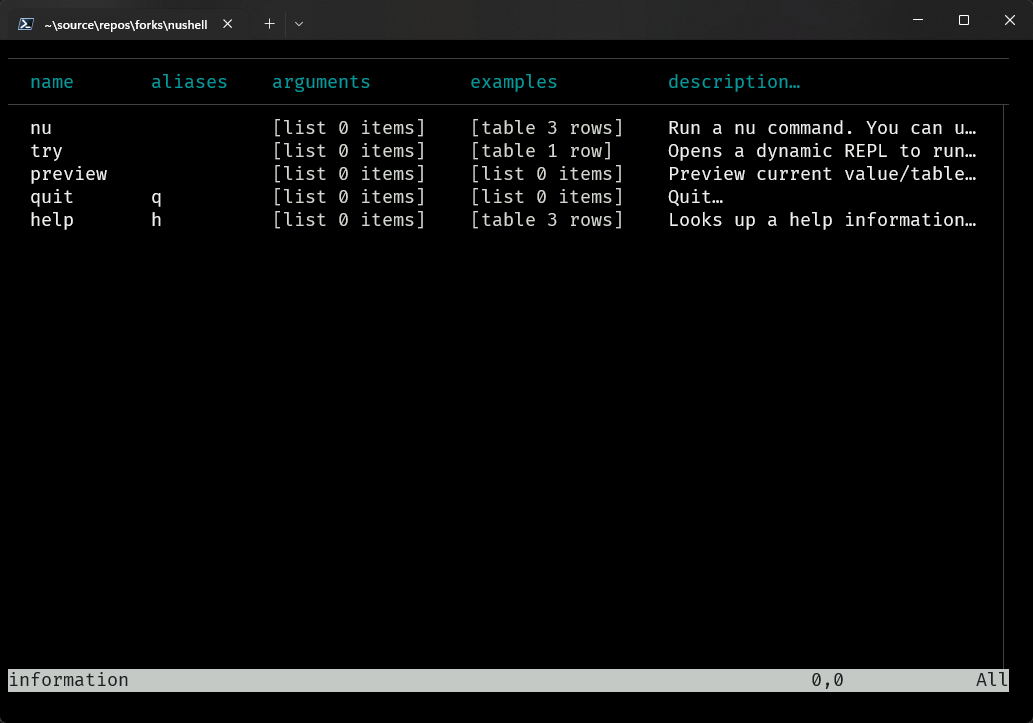
If you then type `:try` you'll get this type of window where you can
type in the top portion and see results in the bottom.
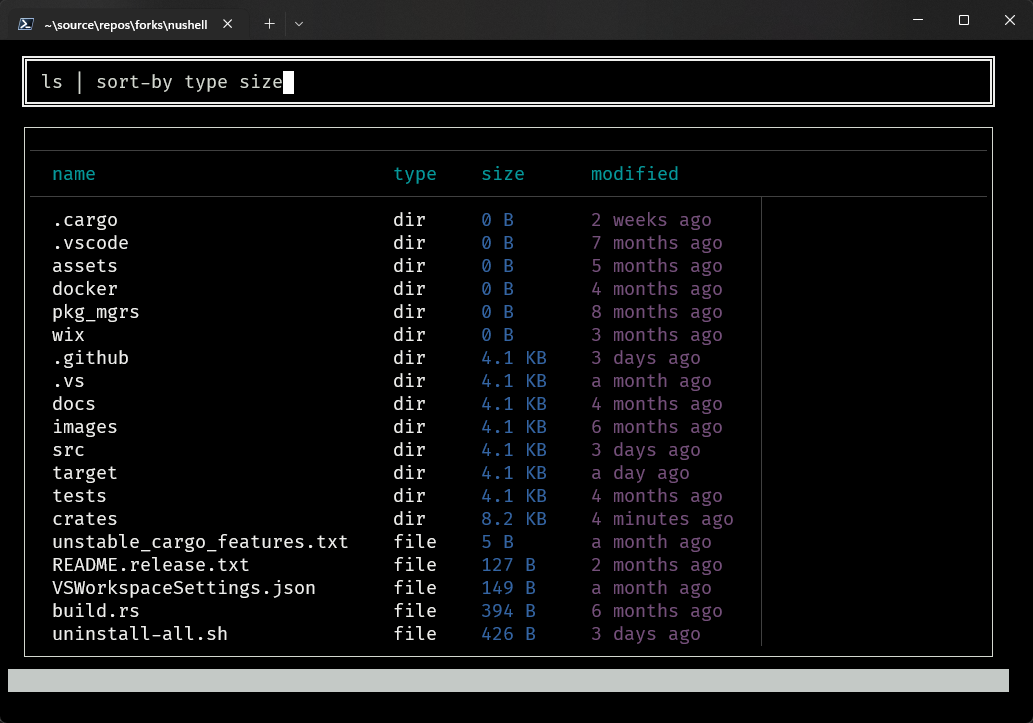
The `:nu` command is interesting because you can type pipelines like
`:nu ls | sort-by type size` or another pipeline of your choosing such
as `:nu sys` and that will show the table that looks like this, which
we're calling "table mode".
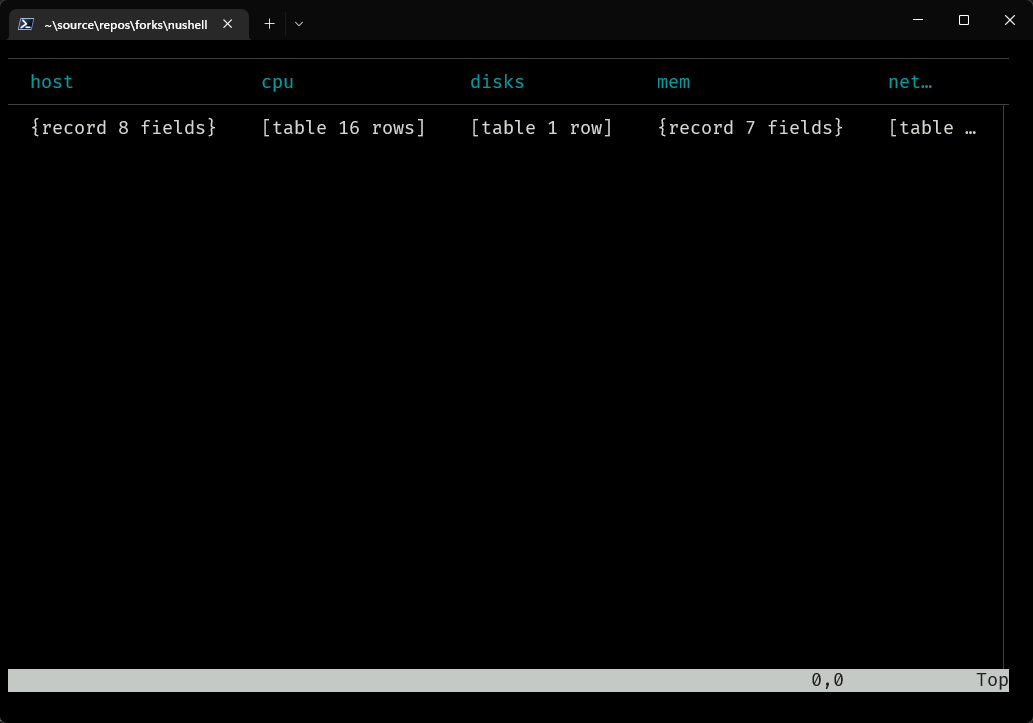
If you hit the `t` key it will now transpose the view to look like this.
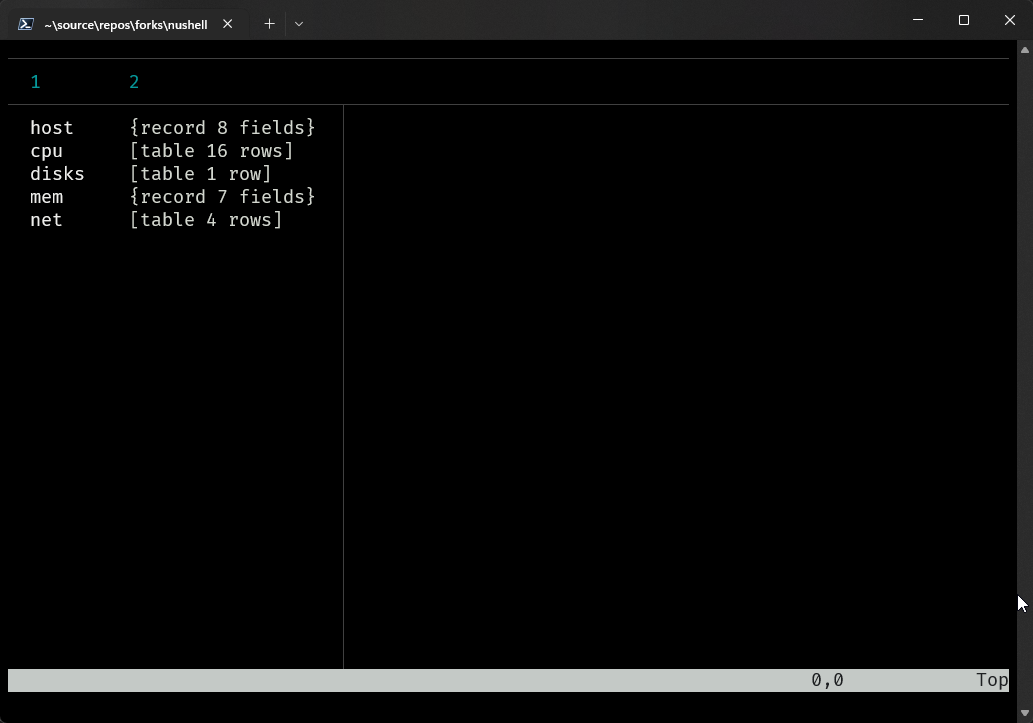
In table mode or transposed table mode you can use the `i` key to
inspect any collapsed field like `{record 8 fields}`, `[table 16 rows]`,
`[list x]`, etc.
One of the original benefits was that when you're in a view that has a
lot of columns, `explore` gives you the ability to scroll left, right,
up, and down.
`explore` is also smart enough to know when you're in table mode versus
preview mode. If you do `open Cargo.toml | explore` you get this.
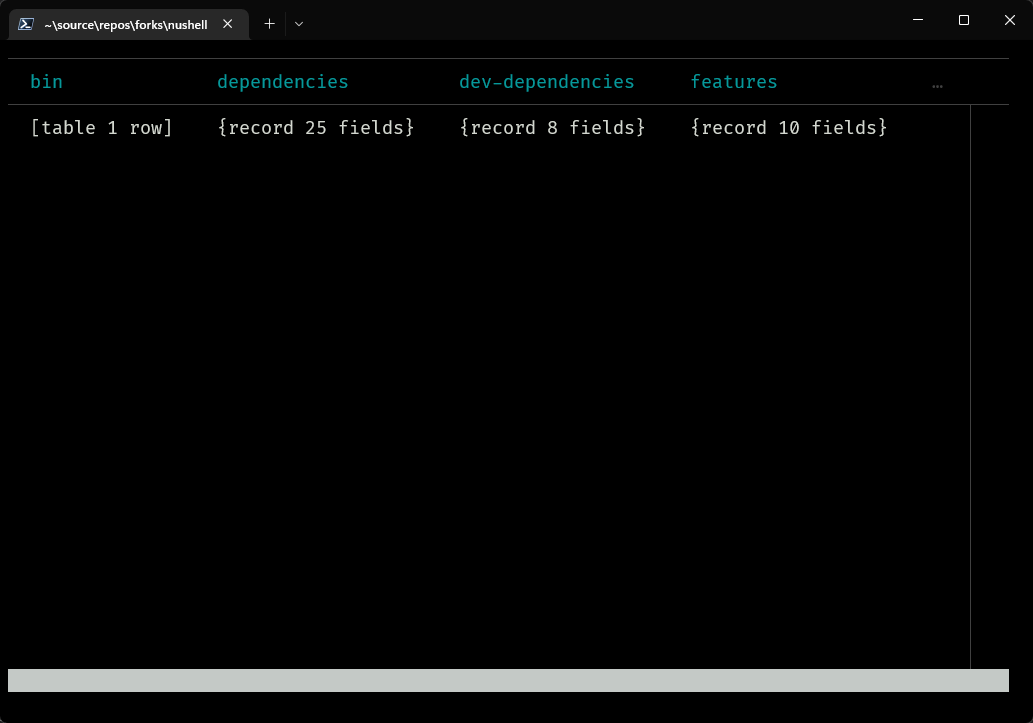
If you type `open --raw Cargo.toml | explore` you get this where you can
scroll left, right, up, down. This is called preview mode.
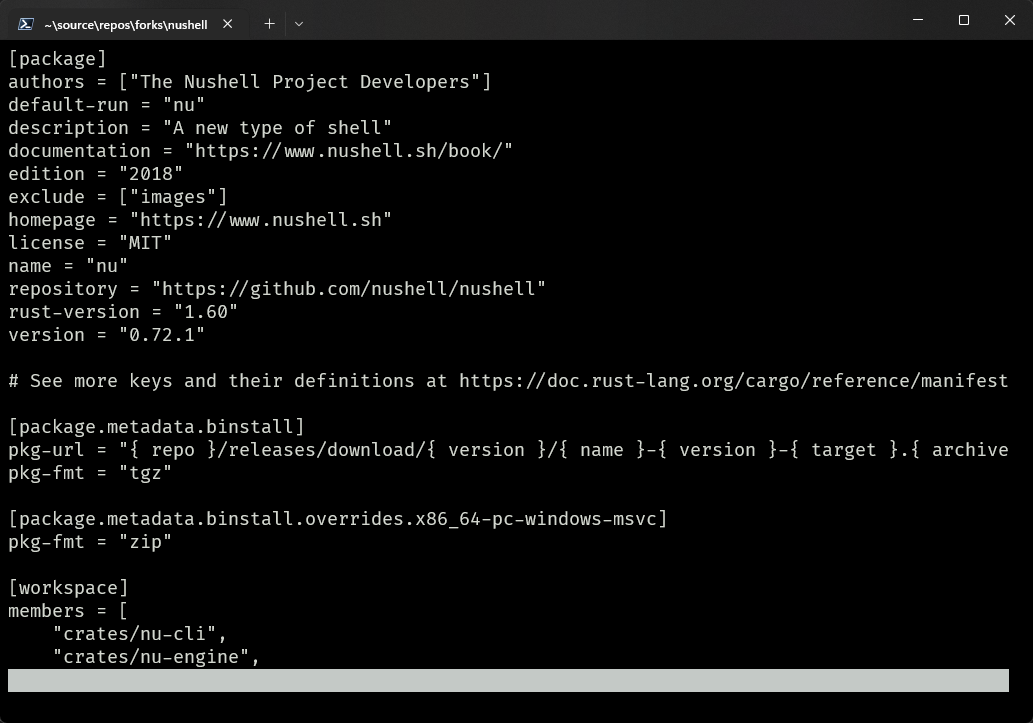
When you're in table mode, you can also type `:preview`. So, with `open
--raw Cargo.toml | explore`, if you type `:preview`, it will look like
this.
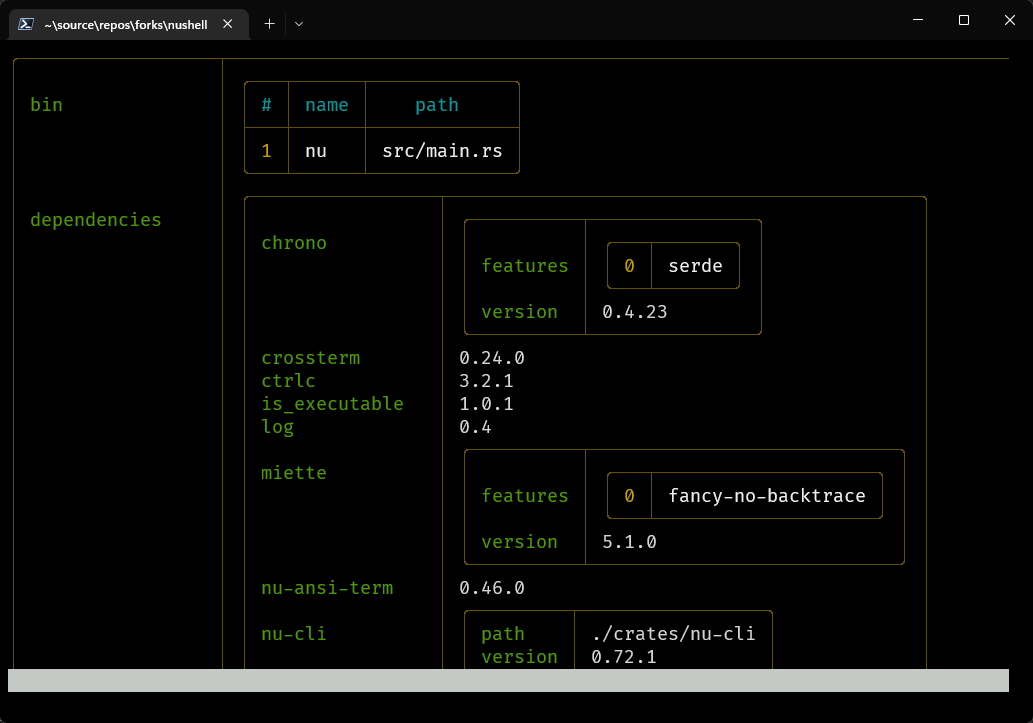
Signed-off-by: Maxim Zhiburt <zhiburt@gmail.com>
Co-authored-by: Darren Schroeder <343840+fdncred@users.noreply.github.com>
2022-12-01 16:32:10 +01:00
|
|
|
[package]
|
|
|
|
|
authors = ["The Nushell Project Developers"]
|
2023-05-27 10:18:39 +02:00
|
|
|
description = "Nushell table pager"
|

[MVP][WIP] `less` like pager (#6984)
Run it as `explore`.
#### example
```nu
ls | explore
```
Configuration points in `config.nu` file.
```
# A 'explore' utility config
explore_config: {
highlight: { bg: 'yellow', fg: 'black' }
status_bar: { bg: '#C4C9C6', fg: '#1D1F21' }
command_bar: { fg: '#C4C9C6' }
split_line: '#404040'
cursor: true
# selected_column: 'blue'
# selected_row: { fg: 'yellow', bg: '#C1C2A3' }
# selected_cell: { fg: 'white', bg: '#777777' }
# line_shift: false,
# line_index: false,
# line_head_top: false,
# line_head_bottom: false,
}
```
You can start without a pipeline and type `explore` and it'll give you a
few tips.

If you type `:help` you an see the help screen with some information on
what tui keybindings are available.

From the `:help` screen you can now hit `i` and that puts you in
`cursor` aka `inspection` mode and you can move the cursor left right up
down and it you put it on an area such as `[table 5 rows]` and hit the
enter key, you'll see something like this, which shows all the `:`
commands. If you hit `esc` it will take you to the previous screen.

If you then type `:try` you'll get this type of window where you can
type in the top portion and see results in the bottom.

The `:nu` command is interesting because you can type pipelines like
`:nu ls | sort-by type size` or another pipeline of your choosing such
as `:nu sys` and that will show the table that looks like this, which
we're calling "table mode".

If you hit the `t` key it will now transpose the view to look like this.

In table mode or transposed table mode you can use the `i` key to
inspect any collapsed field like `{record 8 fields}`, `[table 16 rows]`,
`[list x]`, etc.
One of the original benefits was that when you're in a view that has a
lot of columns, `explore` gives you the ability to scroll left, right,
up, and down.
`explore` is also smart enough to know when you're in table mode versus
preview mode. If you do `open Cargo.toml | explore` you get this.

If you type `open --raw Cargo.toml | explore` you get this where you can
scroll left, right, up, down. This is called preview mode.

When you're in table mode, you can also type `:preview`. So, with `open
--raw Cargo.toml | explore`, if you type `:preview`, it will look like
this.

Signed-off-by: Maxim Zhiburt <zhiburt@gmail.com>
Co-authored-by: Darren Schroeder <343840+fdncred@users.noreply.github.com>
2022-12-01 16:32:10 +01:00
|
|
|
repository = "https://github.com/nushell/nushell/tree/main/crates/nu-explore"
|
|
|
|
|
edition = "2021"
|
|
|
|
|
license = "MIT"
|
|
|
|
|
name = "nu-explore"
|
2024-07-30 02:20:55 +02:00
|
|
|
version = "0.96.2"
|

[MVP][WIP] `less` like pager (#6984)
Run it as `explore`.
#### example
```nu
ls | explore
```
Configuration points in `config.nu` file.
```
# A 'explore' utility config
explore_config: {
highlight: { bg: 'yellow', fg: 'black' }
status_bar: { bg: '#C4C9C6', fg: '#1D1F21' }
command_bar: { fg: '#C4C9C6' }
split_line: '#404040'
cursor: true
# selected_column: 'blue'
# selected_row: { fg: 'yellow', bg: '#C1C2A3' }
# selected_cell: { fg: 'white', bg: '#777777' }
# line_shift: false,
# line_index: false,
# line_head_top: false,
# line_head_bottom: false,
}
```
You can start without a pipeline and type `explore` and it'll give you a
few tips.

If you type `:help` you an see the help screen with some information on
what tui keybindings are available.

From the `:help` screen you can now hit `i` and that puts you in
`cursor` aka `inspection` mode and you can move the cursor left right up
down and it you put it on an area such as `[table 5 rows]` and hit the
enter key, you'll see something like this, which shows all the `:`
commands. If you hit `esc` it will take you to the previous screen.

If you then type `:try` you'll get this type of window where you can
type in the top portion and see results in the bottom.

The `:nu` command is interesting because you can type pipelines like
`:nu ls | sort-by type size` or another pipeline of your choosing such
as `:nu sys` and that will show the table that looks like this, which
we're calling "table mode".

If you hit the `t` key it will now transpose the view to look like this.

In table mode or transposed table mode you can use the `i` key to
inspect any collapsed field like `{record 8 fields}`, `[table 16 rows]`,
`[list x]`, etc.
One of the original benefits was that when you're in a view that has a
lot of columns, `explore` gives you the ability to scroll left, right,
up, and down.
`explore` is also smart enough to know when you're in table mode versus
preview mode. If you do `open Cargo.toml | explore` you get this.

If you type `open --raw Cargo.toml | explore` you get this where you can
scroll left, right, up, down. This is called preview mode.

When you're in table mode, you can also type `:preview`. So, with `open
--raw Cargo.toml | explore`, if you type `:preview`, it will look like
this.

Signed-off-by: Maxim Zhiburt <zhiburt@gmail.com>
Co-authored-by: Darren Schroeder <343840+fdncred@users.noreply.github.com>
2022-12-01 16:32:10 +01:00
|
|
|
|
2023-02-12 23:22:00 +01:00
|
|
|
[lib]
|
|
|
|
|
bench = false
|
|
|
|
|
|

[MVP][WIP] `less` like pager (#6984)
Run it as `explore`.
#### example
```nu
ls | explore
```
Configuration points in `config.nu` file.
```
# A 'explore' utility config
explore_config: {
highlight: { bg: 'yellow', fg: 'black' }
status_bar: { bg: '#C4C9C6', fg: '#1D1F21' }
command_bar: { fg: '#C4C9C6' }
split_line: '#404040'
cursor: true
# selected_column: 'blue'
# selected_row: { fg: 'yellow', bg: '#C1C2A3' }
# selected_cell: { fg: 'white', bg: '#777777' }
# line_shift: false,
# line_index: false,
# line_head_top: false,
# line_head_bottom: false,
}
```
You can start without a pipeline and type `explore` and it'll give you a
few tips.

If you type `:help` you an see the help screen with some information on
what tui keybindings are available.

From the `:help` screen you can now hit `i` and that puts you in
`cursor` aka `inspection` mode and you can move the cursor left right up
down and it you put it on an area such as `[table 5 rows]` and hit the
enter key, you'll see something like this, which shows all the `:`
commands. If you hit `esc` it will take you to the previous screen.

If you then type `:try` you'll get this type of window where you can
type in the top portion and see results in the bottom.

The `:nu` command is interesting because you can type pipelines like
`:nu ls | sort-by type size` or another pipeline of your choosing such
as `:nu sys` and that will show the table that looks like this, which
we're calling "table mode".

If you hit the `t` key it will now transpose the view to look like this.

In table mode or transposed table mode you can use the `i` key to
inspect any collapsed field like `{record 8 fields}`, `[table 16 rows]`,
`[list x]`, etc.
One of the original benefits was that when you're in a view that has a
lot of columns, `explore` gives you the ability to scroll left, right,
up, and down.
`explore` is also smart enough to know when you're in table mode versus
preview mode. If you do `open Cargo.toml | explore` you get this.

If you type `open --raw Cargo.toml | explore` you get this where you can
scroll left, right, up, down. This is called preview mode.

When you're in table mode, you can also type `:preview`. So, with `open
--raw Cargo.toml | explore`, if you type `:preview`, it will look like
this.

Signed-off-by: Maxim Zhiburt <zhiburt@gmail.com>
Co-authored-by: Darren Schroeder <343840+fdncred@users.noreply.github.com>
2022-12-01 16:32:10 +01:00
|
|
|
[dependencies]
|
2024-07-30 02:20:55 +02:00
|
|
|
nu-protocol = { path = "../nu-protocol", version = "0.96.2" }
|
|
|
|
|
nu-parser = { path = "../nu-parser", version = "0.96.2" }
|
|
|
|
|
nu-color-config = { path = "../nu-color-config", version = "0.96.2" }
|
|
|
|
|
nu-engine = { path = "../nu-engine", version = "0.96.2" }
|
|
|
|
|
nu-table = { path = "../nu-table", version = "0.96.2" }
|
|
|
|
|
nu-json = { path = "../nu-json", version = "0.96.2" }
|
|
|
|
|
nu-utils = { path = "../nu-utils", version = "0.96.2" }
|
2024-03-07 23:40:31 +01:00
|
|
|
nu-ansi-term = { workspace = true }
|
2024-07-30 02:20:55 +02:00
|
|
|
nu-pretty-hex = { path = "../nu-pretty-hex", version = "0.96.2" }
|

[MVP][WIP] `less` like pager (#6984)
Run it as `explore`.
#### example
```nu
ls | explore
```
Configuration points in `config.nu` file.
```
# A 'explore' utility config
explore_config: {
highlight: { bg: 'yellow', fg: 'black' }
status_bar: { bg: '#C4C9C6', fg: '#1D1F21' }
command_bar: { fg: '#C4C9C6' }
split_line: '#404040'
cursor: true
# selected_column: 'blue'
# selected_row: { fg: 'yellow', bg: '#C1C2A3' }
# selected_cell: { fg: 'white', bg: '#777777' }
# line_shift: false,
# line_index: false,
# line_head_top: false,
# line_head_bottom: false,
}
```
You can start without a pipeline and type `explore` and it'll give you a
few tips.

If you type `:help` you an see the help screen with some information on
what tui keybindings are available.

From the `:help` screen you can now hit `i` and that puts you in
`cursor` aka `inspection` mode and you can move the cursor left right up
down and it you put it on an area such as `[table 5 rows]` and hit the
enter key, you'll see something like this, which shows all the `:`
commands. If you hit `esc` it will take you to the previous screen.

If you then type `:try` you'll get this type of window where you can
type in the top portion and see results in the bottom.

The `:nu` command is interesting because you can type pipelines like
`:nu ls | sort-by type size` or another pipeline of your choosing such
as `:nu sys` and that will show the table that looks like this, which
we're calling "table mode".

If you hit the `t` key it will now transpose the view to look like this.

In table mode or transposed table mode you can use the `i` key to
inspect any collapsed field like `{record 8 fields}`, `[table 16 rows]`,
`[list x]`, etc.
One of the original benefits was that when you're in a view that has a
lot of columns, `explore` gives you the ability to scroll left, right,
up, and down.
`explore` is also smart enough to know when you're in table mode versus
preview mode. If you do `open Cargo.toml | explore` you get this.

If you type `open --raw Cargo.toml | explore` you get this where you can
scroll left, right, up, down. This is called preview mode.

When you're in table mode, you can also type `:preview`. So, with `open
--raw Cargo.toml | explore`, if you type `:preview`, it will look like
this.

Signed-off-by: Maxim Zhiburt <zhiburt@gmail.com>
Co-authored-by: Darren Schroeder <343840+fdncred@users.noreply.github.com>
2022-12-01 16:32:10 +01:00
|
|
|
|

`explore`: adopt `anyhow`, support `CustomValue`, remove help system (#12692)
This PR:
1. Adds basic support for `CustomValue` to `explore`. Previously `open
foo.db | explore` didn't really work, now we "materialize" the whole
database to a `Value` before loading it
2. Adopts `anyhow` for error handling in `explore`. Previously we were
kind of rolling our own version of `anyhow` by shoving all errors into a
`std::io::Error`; I think this is much nicer. This was necessary because
as part of 1), collecting input is now fallible...
3. Removes a lot of `explore`'s fancy command help system.
- Previously each command (`:help`, `:try`, etc.) had a sophisticated
help system with examples etc... but this was not very visible to users.
You had to know to run `:help :try` or view a list of commands with
`:help :`
- As discussed previously, we eventually want to move to a less modal
approach for `explore`, without the Vim-like commands. And so I don't
think it's worth keeping this command help system around (it's
intertwined with other stuff, and making these changes would have been
harder if keeping it).
4. Rename the `--reverse` flag to `--tail`. The flag scrolls to the end
of the data, which IMO is described better by "tail"
5. Does some renaming+commenting to clear up things I found difficult to
understand when navigating the `explore` code
I initially thought 1) would be just a few lines, and then this PR blew
up into much more extensive changes 😅
## Before
The whole database was being displayed as a single Nuon/JSON line 🤔

## After
The database gets displayed like a record

## Future work
It is sort of annoying that we have to load a whole SQLite database into
memory to make this work; it will be impractical for large databases.
I'd like to explore improvements to `CustomValue` that can make this
work more efficiently.
2024-05-02 00:34:37 +02:00
|
|
|
anyhow = { workspace = true }
|
|
|
|
|
log = { workspace = true }
|
2024-03-24 00:46:02 +01:00
|
|
|
terminal_size = { workspace = true }
|
|
|
|
|
strip-ansi-escapes = { workspace = true }
|
2024-03-07 23:40:31 +01:00
|
|
|
crossterm = { workspace = true }
|

`explore`: adopt `anyhow`, support `CustomValue`, remove help system (#12692)
This PR:
1. Adds basic support for `CustomValue` to `explore`. Previously `open
foo.db | explore` didn't really work, now we "materialize" the whole
database to a `Value` before loading it
2. Adopts `anyhow` for error handling in `explore`. Previously we were
kind of rolling our own version of `anyhow` by shoving all errors into a
`std::io::Error`; I think this is much nicer. This was necessary because
as part of 1), collecting input is now fallible...
3. Removes a lot of `explore`'s fancy command help system.
- Previously each command (`:help`, `:try`, etc.) had a sophisticated
help system with examples etc... but this was not very visible to users.
You had to know to run `:help :try` or view a list of commands with
`:help :`
- As discussed previously, we eventually want to move to a less modal
approach for `explore`, without the Vim-like commands. And so I don't
think it's worth keeping this command help system around (it's
intertwined with other stuff, and making these changes would have been
harder if keeping it).
4. Rename the `--reverse` flag to `--tail`. The flag scrolls to the end
of the data, which IMO is described better by "tail"
5. Does some renaming+commenting to clear up things I found difficult to
understand when navigating the `explore` code
I initially thought 1) would be just a few lines, and then this PR blew
up into much more extensive changes 😅
## Before
The whole database was being displayed as a single Nuon/JSON line 🤔

## After
The database gets displayed like a record

## Future work
It is sort of annoying that we have to load a whole SQLite database into
memory to make this work; it will be impractical for large databases.
I'd like to explore improvements to `CustomValue` that can make this
work more efficiently.
2024-05-02 00:34:37 +02:00
|
|
|
once_cell = { workspace = true }
|
2024-03-24 00:46:02 +01:00
|
|
|
ratatui = { workspace = true }
|
|
|
|
|
ansi-str = { workspace = true }
|
|
|
|
|
unicode-width = { workspace = true }
|
|
|
|
|
lscolors = { workspace = true, default-features = false, features = [
|
2024-02-08 01:15:45 +01:00
|
|
|
"nu-ansi-term",
|
2024-06-25 20:29:47 +02:00
|
|
|
] }
|